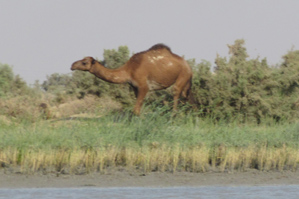Ecosystems serve up a healthy portion of prevention

A few months ago incoming faculty member Brian Helmuth saw a camel on the side of a river in the East Hammar Marsh in Basra, Iraq. “At first I thought, ‘oh yeah you know that’s cool,'” he recalled. “And then I realized, yeah — camels don’t belong in marshes.”
The Hammar Marsh, seated at the intersection of the Tigris and Euphrates rivers, is thought to have been the location of the Garden of Eden — that zenith of green spaces, that picture of fertility. Today, Helmuth told me, the marsh and nearby Basra are ground zero for water insecurity. The marshes around which the area’s entire culture was built have receded by 90 percent. The rivers are drying up. Salt sediment is creeping its way closer and closer to the city, which is about 100 km from shore.
Why is all this happening, you ask? I had the same question.
At the end of the first gulf war, Helmuth told me, Saddam Hussein had the world’s largest canals built under the guise of road-making. Coupled with climate change and massive dams in Syria and Turkey, this “development” has nearly decimated the area, which is mainly inhabited by Shia Muslims.
When Helmuth visited, it hadn’t rained in six months.
Whether we like it or not, our actions have an impact on the land and its ability to support life. Whether we like it or not, climate change is happening…quickly. So we’d better start preparing, said Helmuth.
Yesterday marked the one month anniversary of Hurricane Sandy. The storm had devastating impacts around the world. It caused the first weather-related close of the NY stock exchange since 1985, left millions without power for several days, and initiated a gasoline rationing program that is just now coming to an end.
Weather forecasting is nothing new — we can predict the path of a hurricane with pretty good accuracy these days. But even with advanced warning, no amount of last minute preparations could have saved New York from the destruction it experienced. Our built environment, as I wrote a couple weeks ago, is simply not very good at dealing with climate change impacts.
From reduced rainfall in the marshes of Basra to devastating hurricanes in the northeastern US, climate change is demanding a new approach to the way we interact with the land.

The uncharacteristically dry conditions have caused a wave of fires in the Basra area. Photo by Brian Helmuth.
Helmuth, a marine biologist who uses climate change models to predict areas of vulnerability in order to develop appropriate preparative actions, said that one proposed solution in Basra has been to plant mangrove trees to stabilize sediments along the Persian Gulf. These trees have complex root systems that provide structure for ecosystem growth as well as filtering capabilities, which could help manage the sediment run-off mentioned earlier. This kind of development stands in direct relief to the standard approach of building concrete walls wherever we see water problems. Mangroves would actually help replenish some of the fertility that has been lost from the area.
Helmuth will join the Marine and Environmental Sciences faculty in January and is spearheading the new Sustainability Science and Policy Initiative, a joint program of the College of Science and the School of Public Policy and Urban Affairs. He is putting together an international network of marine labs to pool resources on studying the impacts of climate change on coastal communities (this is what brought him to Iraq).
“One really interesting question and one that hasn’t been addressed,” he said, “is when can we build hard structures to make us safe from things like Sandy versus when do we preserve and enhance natural ecosystems as a way of making ourselves resilient?”
The mangroves in Basra are a good example of the latter. Ecosystems can provide us with a variety of services, he said. Work taking place in Jon Grabowski’s lab, for instance, looks at how oyster reefs can be used to provide structure as a protection against erosion while also filtering pollutants out of seawater.
But in places like New York, we might be too far gone, said Helmuth. Concrete structures are pretty much all that’s left in many of our coastal cities, so the solution there may not be so simple as building oyster beds or planting mangrove trees. Instead, he said, we need to think of ways to disperse impacts when they happen.
One of the biggest issues after Sandy was the power outages. Flooding caused fires which caused transformers to blow up. Since the power grid in New York — as in most places — is totally centralized, a single transformer powers vast reaches of the island. When one goes, thousands of people are instantly affected. A so-called “smart grid,” with decentralized control, would be a much more resilient approach, he said.
As always, the key point here is for policy makers and scientists to be on the same page. Helmuth’s new role at the university is intended to facilitate cross-talk between those two groups. The Sustainability Science and Policy Initiative is part of a larger initiative of the College of Science on urban coastal sustainability.
